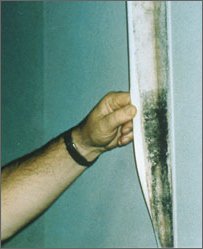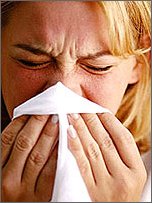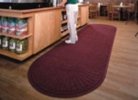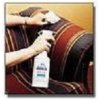The 6 Most Dangerous Home-Based Causes of Disease and Illness
by www.SixWise.com
Your home is your haven, but inside even the most pristine of houses lurk hidden dangers that can cause disease and illness to you and your family.
What makes these home-based toxins so dangerous is that often you can't tell they're there until it's too late and you're already sick. That is, of course, unless you know where and how to look ...
1. Gases
Radon - the number two cause of the most deadly form of cancer, lung cancer -- is an extremely toxic, odorless, colorless gas that could affect any home. It comes from the soil and rock beneath your home and also from well water and building materials.
According to the U.S. Environmental Protection Agency (EPA), nearly one out of every 15 U.S. homes is estimated to have elevated radon levels. Over time, breathing in radon gas can damage lung tissue and lead to lung cancer.
Testing is the ONLY way to determine if radon is in your home because it can't be smelled, tasted or seen. The good news is that testing your home's air for this poisonous gas is easy with the Do-It-Yourself Home Radon Test Kit.
Another invisible, odorless, yet poisonous, gas is carbon monoxide (CO)--it's responsible for killing almost 4,000 people in the United States each year. CO is produced when fuels from your fireplace, water heater, boiler or furnace burn incompletely, and it can fill a home without anyone taking notice. Once exposed, symptoms include headaches, nausea, dizziness, fatigue, shortness of breath, unconsciousness and even death. Like with radon, a carbon monoxide detector is the only way to detect the gas in your home.
|

Mold in your home (here it's growing on the back of wallpaper) can lead to allergies, asthma and immunologic effects. |
2. Mold
According to the Environmental Protection Agency (EPA), 30 percent to 50 percent of all structures have damp conditions that could encourage the growth and spread of biological pollutants like mold. And that's just for average climates; in warm, moist climates, this percentage is likely much higher.
When mold grows on your walls, carpets or other materials, portions of it are transferred to the indoor air you breathe. According to the EPA, this can lead to symptoms such as:
-
Allergic reactions (e.g., rhinitis and dermatitis or skin rash)
-
Asthma
-
Hypersensitivity pneumonitis
-
Other immunologic effects
If you suspect mold is in your home (some indications include stained ceilings, a musty or earthy smell, black, pink, orange or green spots on walls, flood or hurricane damage, damp basement) you should seek out a professional (a certified mold remediator or a certified mold contractor) to evaluate your home and perform the removal.
3. Dust
Dust is the collective term used to describe the wide variety of organic and inorganic particles that collect in our homes, including human skin cells, flame retardants like polybrominated diphenyl ethers (PBDE), paint particles, cigarette smoke (and its toxic byproducts, pesticides, PCBs, rodent waste, mold spores, viruses and more.
What makes dust so dangerous is that as you walk, all of these unsavory particles are circulated into the air for you to breathe in and absorb.
|

Household dust can lead to much more than just sneezing. It can contain toxic compounds linked to a host of diseases. |
What can be done? There are three major pathways to keeping dust levels in your home at a minimum:
A. Purify your home's air. A high-quality air treatment system is essential to having clean indoor air, but choosing the right type can be a cumbersome task, given the numerous models on the market (and their quality varies drastically).
B. Dust your home--often and with the right tools. What's the optimum choice for dusting? PerfectClean's Complete Mop and Dusting Kit. Rather than just pushing dust around, or worse, stirring it up into the air, all PerfectClean products are made with positively charged ultramicrofibers that pick up everything in their path--including dust and all of its microscopic attachments.
C. Use High-Quality Doormats. A chief way chemicals, pesticides and other contaminants enter your home is through dust and dirt you track in on the bottom of your shoes. It's then circulated directly into the air you and your family breathe.
Trapping dirt right at the door, via doormats placed strategically around your home, can therefore go a long way toward reducing the amount of dust and toxins in your home's air. SixWise.com highly recommends the Waterhog Grand Premier Mats for this purpose. Unlike other mats out there, Waterhogs have a distinctive "water-dam" border that traps soil and liquids in the mat so they don't drain or track onto your floors ... while vastly minimizing slipping.
4. Toxic chemical solutions
Cleaning products are loaded with caustic detergents, harsh chemicals and toxic residues. This applies to the whole variety: spray cleaners, toilet bowl cleaners, laundry detergents, you name it.
Many of the individual substances in these products have been linked to cancer, reproductive problems and damage to the central nervous system. To date, no one knows what the cumulative effects of exposure to these chemical cocktails will be.
If you're looking for a top-notch cleaning line that's completely safe for you and the environment, we highly recommend the EnviroRite line of non-toxic cleaning products they contain no hazardous ingredients, petrochemicals, perfumes, dyes or animal byproducts.
|
A Key, Innovative Way to Keep Dust and Dirt Out of Your Home
 Every step you take into your home presents an opportunity for dirt and toxins to get in and circulate in your air. That's why The Waterhog Grand Premier Mats and Rugs, placed strategically around your home at entranceways and highly trafficked areas, are essential to keeping your home air clean! Every step you take into your home presents an opportunity for dirt and toxins to get in and circulate in your air. That's why The Waterhog Grand Premier Mats and Rugs, placed strategically around your home at entranceways and highly trafficked areas, are essential to keeping your home air clean!
These premier decorative mats and rugs:
- Keep Dirt and Liquids Beneath Shoe Level
- Dry Very Fast and Resist Corrosion
- Won't Slip
- Last Much Longer Than Other Mats
- Are Simple to Clean
- Are Attractive and Affordable
- Can be used Indoors or Outdoors
- Come in a Variety of Colors & Sizes
Learn Why You Should Avoid Other Mats, Why The Waterhog Grand Premier Mats are Superior! |
5. Phthalates
These endocrine-disrupting chemicals are ubiquitous in today's environment. Most commonly they're used to soften plastics, but they're also in a host of other products like fragrances, hair spray and nail polish.
One in particular, bis(2-ethylhexyl) phthalate (DEHP), which the National Institutes of Health (NIH) says is "reasonably anticipated to be a human carcinogen," was found in the dust of every home in the study. DEHP is used to make children's toys, shower curtains, raincoats, shoes and floor tiles.
It may be next to impossible to completely avoid phthalates in your home, but you can try to cut down your exposure by using glass containers to store your food and choosing natural products for personal care products like perfume and nail polish.
6. Pests
We all know that mice and other pests are unsightly, but they can be downright dangerous too. For instance, a study done by researchers at Johns Hopkins Children's Center found that of 100 inner-city bedrooms of children with asthma, 84 percent had detectable levels of airborne mouse allergen!
And that's not all. Mice can also spread the Hantavirus, which causes a disease known as Hantavirus pulmonary syndrome (HPS). You become infected after mice droppings, urine or saliva get into your household dust, which you subsequently breathe in.
Mice and other pests can be very illusive, so you may not even know they're in your home. Here are three telltale signs to look out for if you suspect (and even if you don't) mice may have infested your home:
- Cracks and holes in walls or doors
- Open food left out in the kitchen
- Mouse droppings on floors, counters or in cabinets
|
Enviro-Rite Non-Toxic Cleaning Line:
Safe Cleaning Products for a Healthy Home
 Unlike most cleaning solutions on the market that contain harsh detergents, synthetic chemicals and harmful additives, the Enviro-Rite cleaning line is completely safe--they contain no hazardous ingredients, petrochemicals, perfumes, dyes or animal byproducts. Unlike most cleaning solutions on the market that contain harsh detergents, synthetic chemicals and harmful additives, the Enviro-Rite cleaning line is completely safe--they contain no hazardous ingredients, petrochemicals, perfumes, dyes or animal byproducts.
And, they're incredibly effective for all of your cleaning needs:
-
Enviro-Rite Carpet & Upholstery Cleaner: Intended for use on both carpet and upholstery, EnviroRite Carpet Cleaner is an excellent vegetable-based cleaning concentrate that replaces all petroleum-based formulations.
-
Enviro-Rite Dish Washing Liquid: Kitchen Sink Dishwashing Liquid makes quick work of dirty dishes and contains soy's natural moisturizing qualities to make washing dishes smoothing to your hands!
-
Enviro-Rite Spot Lifter: Spot Lift is an excellent, ready-to-use carpet and upholstery cleaning solution that makes house cleaning easy, effective and hazard-free!
-
Enviro-Rite Glass & Plexi Cleaner: Clearly Clean is a ready-to-use, high performance cleaning solution made with naturally occurring, renewable ingredients.
Check out the entire Enviro-Rite Non-Toxic Cleaning Line Now! |
Recommended Reading
Organophosphates: What You Don't Know Can Indeed Hurt You
Twelve of the World's Most Dangerous Countries: A Very Brief Tour
EPA: Mold: Health Effects and Symptoms
Are U.S. Homes a Haven for Toxin?
U.S. EPA: Biological Pollutants in Your Home